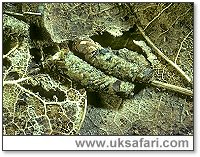
|

|
|
 Sent
to you Sent
to you
by e-mail
|
|
Simply
enter your details and hit the send button
more
info |
|


Click Here

Links
Advertise
Terms of Use
Contributors
About Us
Contact Us
|
 |
Go back
 | Bookmark
| Bookmark
 | Print Page
| Print Page  | E-Mail Us
| E-Mail Us 
The Terrestrial
Caddis
by Tony
Wharton

Photo: Tony Wharton |
|
UK
Safari Tip:
Try using one of our pocket-sized magnifier boxes to get a good close up
look at insects - click here
|
|
Of almost two hundred species of caddis flies found in Britain, all but one have larvae or ‘worms’ that are aquatic. Many, but by no means all, make tubular cases of various materials to protect their bodies as they move around under water. The adults are all terrestrial.
Enoicyla pusilla is the one species that has bucked the trend, in that it lives on land throughout its life cycle. It is a strange insect in other respects, too. Its female is wingless and its range is very restricted, occurring only in Worcestershire and its neighbouring counties.
I first read about it many years ago in Norman E. Hickin’s excellent book “The Natural History of an English Forest”. This is an excellent account of the flora and fauna of Wyre Forest, most of which is in Worcestershire, although Dowles Brook, a tributary of the Severn, flows through the forest and, over much of its length, forms the boundary between that county and
Shropshire. The area in question is part of my local ‘patch’.
In his book Hickin refers to Fletcher and McLachlan, two eminent entomologists who collected the insect from ‘near Worcester’ between 1868 and 1879. The exact location remains a mystery to this day, but, in 1957,
Hickin and his daughter were camping on the banks of Dowles when they discovered that some of the larvae had crawled into their clothes.
I was intrigued when I first read this snippet of information and I set myself the task of finding and photographing the larvae, which are found on the forest floor feeding upon oak leaf litter. Enoicyla pusilla is one of those caddis species whose larvae construct mobile homes for themselves and, on my very first foray in June of that year, I found several, even though their larval cases are only 8 – 9 mm long and 1.5 – 2 mm in diameter, made up largely of grains of sand and tiny pieces of oak leaf litter. I was clearly very lucky, as looking for them is a bit like searching for a needle in a haystack.
Harry Green and Brett Westwood, both of the Worcestershire Trust, have been studying the species and now have 249 records of land caddis on their data base. Their records come mostly from Worcestershire, but parts of the neighbouring counties of Herefordshire, Shropshire and possibly Staffordshire and the West Midlands may figure in the distribution map which Green and Westwood hope to produce in due course.
The photograph of Enoicyla pusilla larvae (above) may not quite match up to the description of the grubs
given by David Harding in his ‘Applied Soil Ecology’. He described them as looking like ‘animated All-bran.

UK Safari Creepy-Crawlies Section
|
 |

|